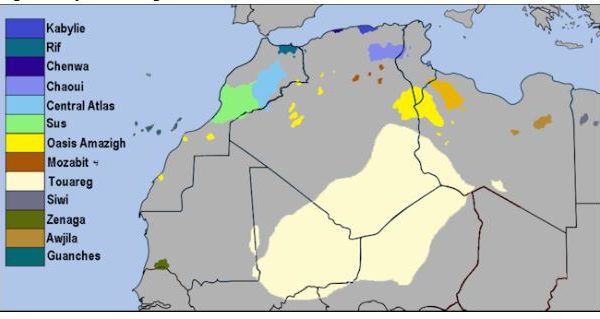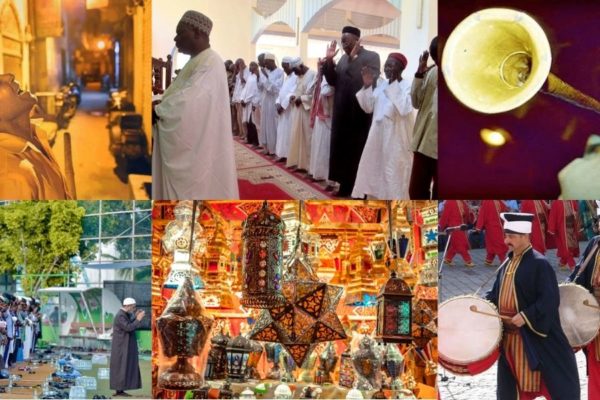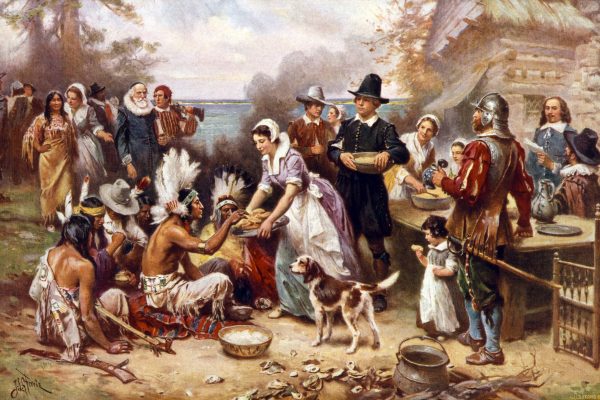For Amazighs, tattoos are generally transmitted from generation to generation, practised by expert women in the Chaouia villages. In the oases of the South, it seems that the women from the same family tattooed each other.
For Amazighs, tattoos are generally transmitted from generation to generation, practised by expert women in the Chaouia villages. In the oases of the South, it seems that the women from the same family tattooed each other.
Amazigh tattoos are part of the oldest rites of Amazigh culture. Since ancient times, Amazigh women in North Africa have customarily had their faces and bodies tattooed, dating back to the pre-Islamic period.
Who are the Amazigh people?
The Amazighs, usually known as Imazighen, are the Indigenous people of North Africa. They refer to themselves as Amazighs, meaning “free men”, and not “Berbers“, which means “barbarians“, a denomination used by the Greeks to describe them.
Today, the term “Berbers” is still mainly used in the West to portray the native inhabitants of North Africa, which the Amazighs disagree with and find pejorative.
Amazigh ethnic groups historically have a presence in more than ten African countries, from the Mediterranean Maghreb to sub-Saharan Africa by way of Egypt and Niger, from the Atlantic Ocean to the shores of the Nile.
Today, there are lots of misconceptions regarding the people of North Africa. Amazighs are often mistaken for Arabs or associated with people of the Middle East by Westerners.
They are indigenous inhabitants of that region who came with their own language -Tamazight- culture and religion. Amazighs also share a common heritage and linguistic origin with various dialects such as Tachelhit-Tamazight-Tarifit-Taqbaylit and Tamasheq.
Before the arrival of Arab conquerors in North Africa, most Amazigh people were pagan. Some in the Coastal plains accepted Christianity under the Romans, while others were Jewish. Muslim conquerors introduced Islam to the North African area in the seventeenth century. As a result, most Amazighs converted to Islam by the eighth century.
Amazighs make up a third of the population in Morocco, a fifth in Algeria, five percent in Libya and a smaller percentage in Tunisia. To this day, it is said that the Amazigh people could count among more than 30 million in North Africa, representing a significant portion of the populations of Algeria, Morocco and Tunisia.
Albeit sharing similar culture, Amazighs are part of many regional sub-tribes that spread in different parts of North Africa, that include:
– Rif, Atlas, and Souss (Morocco),
– Kabylia, Mzab, and Aurès (Algeria),
– Djerba (Tunisia),
– Zuwara and the Nafusa mountains (Libya),
– the Siwa oasis (Egypt),
– the Tuareg-populated Saharan and Sahelian regions —including Azawad— spanning Algeria, Libya, Mali, Niger and Burkina Faso

Among these tribes, we distinguish the most prominent ones, such as the Chleuh of the Moroccan Mountain Atlas, the Kabyles of Northern Algeria, the Tuareg from southwest Libya to Mali, the Chaouia of Eastern Algeria, and the Mzab of Sub-Saharian Algeria.
Origin of Amazigh tattoos: purposes, symbols and their meanings
Traditionally worn by women, Amazigh tattoos are part of the oldest ancestral rites that have persisted since Antiquity before beginning to disappear in the 1940s.
Known as “Tricrad“, Amazigh tattoos have various meanings depending on the symbols used by women. We identify at least three primary purposes of Amazigh tattoos.
The first one was purely ornamental. Most Amazigh women were living in the mountains and couldn’t afford jewellery. Thus, they used tattoos to beautify their bodies and faces. Considered a true sign of beauty, mothers encouraged their daughters to tattoo themselves to differentiate their faces from men and make them desirable and attractive.
Maya, a Moroccan woman, living in Canada, whom herself wears Amazigh tattoos which she inherited from her Amazigh parents, said to ‘The Muslim Vibe’ in an interview:
“Because they could not buy jewellery and henna as it was costly at that time, women tattooed themselves always to look and feel beautiful.”
Another reason why Amazigh women would tattoo themselves was prophylactic. Indeed, these tattoos served to ward off the evil eye for many. Women used them for therapeutic purposes to cure both psychological and physical ailments.
Besides the aesthetic and ornamental functions, Amazigh tattoos aimed to symbolise social status. “Young girls would wear tattoos to highlight the stage of puberty and indicate that girls were ready for marriage“, Maya added.
Much more than aesthetic, Amazigh tattoos are a means of expression and relieving the vagaries of life and a sign of identity and belonging.
Diamonds, triangles, squares, stars, dots, and crescent moons, each of the motifs used to tattoo women, means something special for Amazigh women and conveys a unique story. The kohl, grease smoke, and black coal are the primary materials for filling tattoos.
Generally speaking, Amazigh tattoos are easily distinguished, characterised by fine geometric lines and dots. Their symbolism revolves mainly around values such as frankness, strength, prosperity, tenacity or energy but also around femininity, fertility, marriage, healing, and home.
There is a wide diversity of representations of Amazigh symbols throughout Greater Tamazgha regarding Amazigh tattoos. Maya identifies six symbols with different meanings in most of North Africa.
- The trunk: plant symbol worn on the chin
This trunk tattoo symbolises the rootedness and connexion between the earth, the sky, the divine, and the world and earth energy.
- The mirror: reflection symbol worn on the forehead
The mirror tattoo helps ward off the evil eye and sends back the negative energy to the person responsible for it. It is then considered a protection amulet.
- The bee: resilience symbol worn on the cheeks
The bee tattoo gives strength to make dreams come true.
- The frog: singing symbol worn on the forehead
Women see the frog’s song as pure because this animal is deemed sacred as it lives in the rare waters of the desert.
- The saw: karma symbol worn on the chin
As with most sharp metal objects, the saw protects against the evil eye, but it also returns negative energy, like a boomerang hence the notion of karma.
- Seeds: fertility symbol worn on the cheeks
The seeds tattoo represents the symbol of the cycle of life, in other words, fertility.
For Amazighs, tattoos are generally transmitted from generation to generation, practised by expert women in the Chaouia villages. In the oases of the South, it seems that the women from the same family tattooed each other.
However, as part of the Muslim conquests, when Arabs invaded North Africa, most Amazigh people converted to Islam. As a result, the practice of Amazigh tattoos saw a significant decline in the XXe century, for tattoos in Islam are considered unlawful (haram).
Thus, this is why more and more young women and men today, often descendants of Amazighs, wish to perpetuate this art by choosing to get Amazigh tattoos. Born to Moroccan and Amazigh parents, Maya is one of them.
When asked if the practice of Amazigh tattoos is declining, she said, “Nowadays, there is no decline, but an upsurge of the Amazigh tradition.” She also added, “However, yes, we call talk about a decline following the decolonisation of North African countries. Also, she mentioned how Islam impacted the fading of the Amazigh tradition.
Furthermore, Maya explains that most Amazigh women living in the countryside had their faces and bodies tattooed. So, as they wished to showcase that they were emancipated, they would refuse to get tattoed and move to the city.
The beginning of the 2010s has seen a resurge of Amazigh tattoos due to the North African diaspora’s awakening.
Maya also said that descendants of Amazigh people have seen Westerners appropriate their culture, particularly in reproducing Amazigh tattoos. There is also a new generation of tattoo artists training to carry on the tradition.





